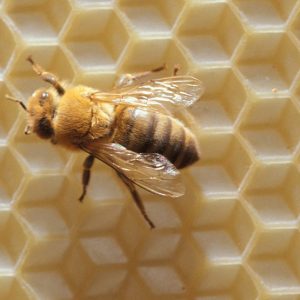calsfoundation@cals.org
Official State Insect
aka: Honeybee
On February 1, 1973, Act 49 of the Arkansas General Assembly designated the honeybee as the state’s official insect. Introduced by Representative Albert “Tom” Collier of Jackson County, the legislation took note of the bee’s important role in crop pollination but primarily extolled the bee’s virtues of diligence, hard work, attention to home defense, and productivity. Act 49 said this “diligent and willing worker typifies the outstanding citizens of the state of Arkansas.”
Arkansas’s designation of the honeybee (Apis mellifera) as a state emblem placed it in the company of fifteen states that have so honored the insect. Several states, such as Oklahoma and Tennessee, have designated multiple insects as state symbols, pairing the laboring honeybee with such graceful “ornamental” insects as butterflies or dragonflies.
Arkansas has long been a significant producer of honey, much of it packed and sold by local apiaries for local consumption. In 2001, when honey sale prices were at a temporary high, Arkansas ranked eighth among honey-producing states. By 2004, Arkansas had slipped to eighteenth, producing 2.28 million pounds. This trend reflected a decline in the number of producing colonies and production per colony. The Arkansas State Plant Board asserts that one-third of food crops rely on natural bee-borne pollination; of this, about eighty percent is accomplished by honeybee colonies. Decline in market prices has forced some apiaries out of business, and other colonies have disappeared through attrition.
Another factor complicating Arkansas’s relationship with its state insect has been the advent of Africanized honeybees, sometimes called “killer bees.” Developed in the 1950s by Brazilian apiarists, these bees are hybrids of the standard European honeybee with selected strains from southern Africa. The result was a bee that produced good quantities of honey in hot climates but exhibited heightened defensive tendencies. Released into the wild by accident, the hybrid bees spread through South and Central America in the 1970s and 1980s and reached the United States by 1990.
By June 2005, Africanized bee colonies were established in several Oklahoma counties bordering Arkansas; in the next month, several were found in Miller and Lafayette counties, with isolated swarms reported in three other counties. Prompt action by the Arkansas State Plant Board, working with the Arkansas Africanized Honey Bee Action Committee, led to educational programs throughout the state. Pest control specialists were authorized to exterminate colonies and swarms when encountered; because Africanized bees are mainly indistinguishable from “regular” European honeybees save by observed behavior or DNA analysis, this policy risks the inadvertent destruction of populations of the latter.
For additional information:
“Arkansas Honey Bees & Africanized Honey Bees.” Arkansas State Plant Board. https://www.agriculture.arkansas.gov/plant-industries/regulatory-section/apiary/arkansas-honey-bees-africanized-honey-bees/ (accessed August 3, 2023).
Horn, Tammy. Bees in America: How the Honey Bee Shaped a Nation. Lexington: University Press of Kentucky, 2005.
Miller, Sara Swan. Ants, Bees and Wasps of North America. New York: Franklin Watts, 2003.
Pringle, Laurence P. Killer Bees. New York: Morrow Junior Books, 1990.
Ware, David. It’s Official! The Real Stories behind Arkansas’s State Symbols. 2nd ed. Little Rock: Butler Center Books, 2017.
Winston, Mark L. Killer Bees: The Africanized Honey Bee in the Americas. Cambridge, MA: Harvard University Press, 1992.
David Ware
Arkansas Secretary of State’s Office
 Agriculture
Agriculture Honeybee, Official State Insect
Honeybee, Official State Insect 



Comments
No comments on this entry yet.